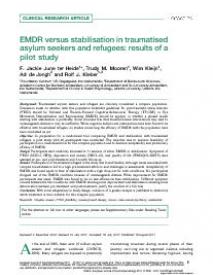EMDR versus stabilisation in traumatised asylum seekers and refugees: results of a pilot study
Background: Traumatised asylum seekers and refugees are clinically considered a complex population.
Discussion exists on whether with this population treatment guidelines for post-traumatic stress disorder
(PTSD) should be followed and Trauma-Focused Cognitive-Behavioural Therapy (TF-CBT) or Eye
Movement Desensitisation and Reprocessing (EMDR) should be applied, or whether a phased model
starting with stabilisation is preferable. Some clinicians fear that trauma-focused interventions may lead to
unmanageable distress or may be ineffective. While cognitive-behavioural interventions have been found to be
effective with traumatised refugees, no studies concerning the efficacy of EMDR with this population have
been conducted as yet.
Objective: In preparation for a randomised trial comparing EMDR and stabilisation with traumatised
refugees, a pilot study with 20 participants was conducted. The objective was to examine feasibility of
participation in a randomised trial for this complex population and to examine acceptability and preliminary
efficacy of EMDR.
Design: Participants were randomly allocated to 11 sessions of either EMDR or stabilisation. Symptoms of
PTSD (SCID-I, HTQ), depression and anxiety (HSCL-25), and quality of life (WHOQOL-BREF) were
assessed at pre- and post-treatment and 3-month follow-up.
Results: Participation of traumatised refugees in the study was found feasible, although issues associated with
complex traumatisation led to a high pre-treatment attrition and challenges in assessments. Acceptability of
EMDR was found equal to that of stabilisation with a high drop-out for both conditions. No participants
dropped out of the EMDR condition because of unmanageable distress. While improvement for EMDR
participants was small, EMDR was found to be no less efficacious than stabilisation. Different symptom
courses between the two conditions, with EMDR showing some improvement and stabilisation showing some
deterioration between pre-treatment and post-treatment, justify the conduct of a full trial.
Conclusion: With some adaptations in study design, inclusion of a greater sample is justifiable to determine
which treatment is more suitable for this complex population.
Geachte bezoeker,
De informatie die u nu opvraagt, kan door psychotraumanet niet aan u worden getoond. Dit kan verschillende redenen hebben,
waarvan (bescherming van het) auteursrecht de meeste voorkomende is. Wanneer het mogelijk is om u door te verwijzen naar de bron
van deze informatie, dan ziet u hier onder een link naar die plek.
Als er geen link staat, kunt u contact opnemen met de bibliotheek,
die u verder op weg kan helpen.
Met vriendelijke groet,
Het psychotraumanet-team.
Reference:
F. Jackie June ter Heide, Trudy M. Mooren, Wim Kleijn, Ad de Jongh, Rolf J. Kleber | 2011
In: European Journal of Psychotraumatology, ISSN 2000-8066 | 2 | 5881
http://www.ncbi.nlm.nih.gov/pmc/articles/PMC3402110/pdf/EJPT-2-5881.pdf
In: European Journal of Psychotraumatology, ISSN 2000-8066 | 2 | 5881
http://www.ncbi.nlm.nih.gov/pmc/articles/PMC3402110/pdf/EJPT-2-5881.pdf
Keywords:
Asylum Seekers, Complex PTSD, Cross Cultural Treatment, Efficacy, EMDR (Eye Movement Desensitization and Reprocessing), Posttraumatic Stress Disorder, PTSD (DSM-5), PTSD (DSM-IV), Randomized Clinical Trial, Refugees, Stabilisation, Torture


